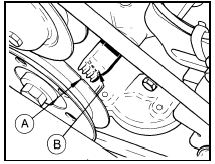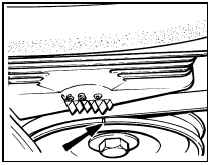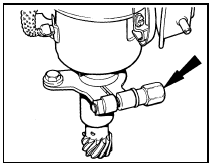Ignition timing check - models with contact breaker distributor (Every 6000 miles or 6 months)
Note: With modern ignition systems the only suitable way to time the ignition accurately is with a stroboscopic timing light. However, for initial setting up purposes (ie after major overhaul, or if the timing has been otherwise completely lost) a basic initial static setting may be used to get the engine started Once the engine is running, the timing should be accurately set using the timing light. Before carrying out any of the following, ensure that the contact breaker points are correctly adjusted as described in Section 13.
1 In order that the engine can run efficiently, it is necessary for a spark to occur at the spark plug and ignite the fuel/air mixture at the instant just before the piston on the compression stroke reaches the top of its travel. The precise instant at which the spark occurs is determined by the ignition timing and this is quoted in degrees before top dead centre (BTDC).
2 If the timing is being checked as a maintenance or service procedure, refer to paragraph 11 onwards. If the distributor has been dismantled or renewed, or if its position on the engine has been altered, obtain an initial static setting as follows.
Static setting
3 Pull off the plug lead and remove No 1
spark plug (nearest the crankshaft pulley).
4 Place a finger over the plug hole and turn the crankshaft in the normal direction of rotation (clockwise from the crankshaft pulley end) until pressure is felt in No 1 cylinder. This indicates that the piston is commencing its compression stroke. The crankshaft can be turned with a spanner on the pulley bolt.
5 Continue turning the crankshaft until the notch on the pulley is aligned with the appropriate mark on the timing scale for the engine being worked on (see Specifications).
On OHV engines the timing scale is cast into the timing cover and situated just above and to the right of the pulley. On CVH engines the scale is moulded into the timing belt cover and is situated directly above the pulley. On all engines the “O” mark on the scale represents Top Dead Centre (TDC) and the raised projections to the left of TDC are in increments of 4° BTDC (see illustrations).

14.5a Timing mark identification - OHV engines
A Notch on crankshaft pulley B Timing scale cast into timing cover

14.5b Crankshaft pulley notch (arrowed) and timing scale - CVH engine
6 Remove the distributor cap and check that the rotor arm is pointing towards the No 1 spark plug lead segment in the cap.
7 Slacken the distributor clamp pinch bolt (OHV engines) or the three distributor flange securing bolts (CVH engines) (see illustration).

14.7 Distributor clamp pinch-bolt location (arrowed) - OHV engines
8 Turn the distributor body anti-clockwise slightly until the contact breaker points are closed, then slowly turn the distributor body clockwise until the points just open. Hold the distributor body in this position and tighten the clamp pinch bolt or flange securing bolts as applicable.
9 Refit the distributor cap, No 1 spark plug and the plug lead.
10 It should now be possible to start and run the engine enabling the timing to be accurately checked with a timing light as follows.
Stroboscopic setting
11 Refer to the Specifications for the timing
setting applicable to the engine being worked
on and then highlight the appropriate mark on
the timing scale and the notch in the pulley
with a dab of white paint (see paragraph 5).
12 Connect a timing light to the engine in accordance with the manufacturer’s instructions (usually between No 1 spark plug and plug lead).
13 Disconnect the vacuum hose at the distributor vacuum unit and plug the hose.
14 Start the engine and allow it to idle.
15 Point the timing light at the timing marks.
They should appear to be stationary with the crankshaft pulley notch in alignment with the appropriate notch on the scale.
16 If adjustment is necessary (ie the marks are not aligned) slacken the distributor clamp pinch bolt or flange securing bolts as applicable, and turn the distributor body as necessary to align the marks. Tighten the pinch bolt or flange bolts when the setting is correct.
17 A secondary use of the timing light is to check that the centrifugal and vacuum advance functions of the distributor are working.
18 The tests are not of course precise as would be the case if sophisticated equipment were used, but will at least indicate the serviceability of the unit.
19 With the engine idling, timing light connected and vacuum pipe disconnected and plugged as described in the preceding paragraphs, increase the engine speed to 2000 rpm and note the approximate distance which the pulley mark moves out of alignment with the mark on the scale.
20 Reconnect the vacuum pipe to the distributor and repeat the test when for the same increase in engine speed, the alignment differential of the timing marks should be greater than previously observed.
21 If the timing marks did not appear to move during the first test, a fault in the distributor centrifugal advance mechanism is indicated.
No increased movement of the marks during the second test indicates a punctured diaphragm in the vacuum unit, or a leak in the vacuum line.
22 On completion of the adjustments and checks, switch off the engine and disconnect the timing light.
See also:
Handbrake lever - removal and refitting
Removal
1 Chock the rear wheels, jack up the front of
the vehicle and support on axle stands.
Release the handbrake. Disconnect the
battery negative lead.
2 Slacken the handbrake cable adjuster.
...
Engine valve clearance check (Every 12 000 miles (20 000 km) or 12 months)
SOHC engines
1 The valve clearances must be checked with
the engine cold. On carburettor models
remove the air cleaner.
2 Disconnect the HT leads from the spark
plugs and release them from the cl ...
What you should know about automotive fuels
Important safety precautions
Do not overfill the fuel tank. The pressure in an overfilled tank
may cause leakage and lead to fuel spray and fire.
The fuel system may be under pressure. If the fue ...
